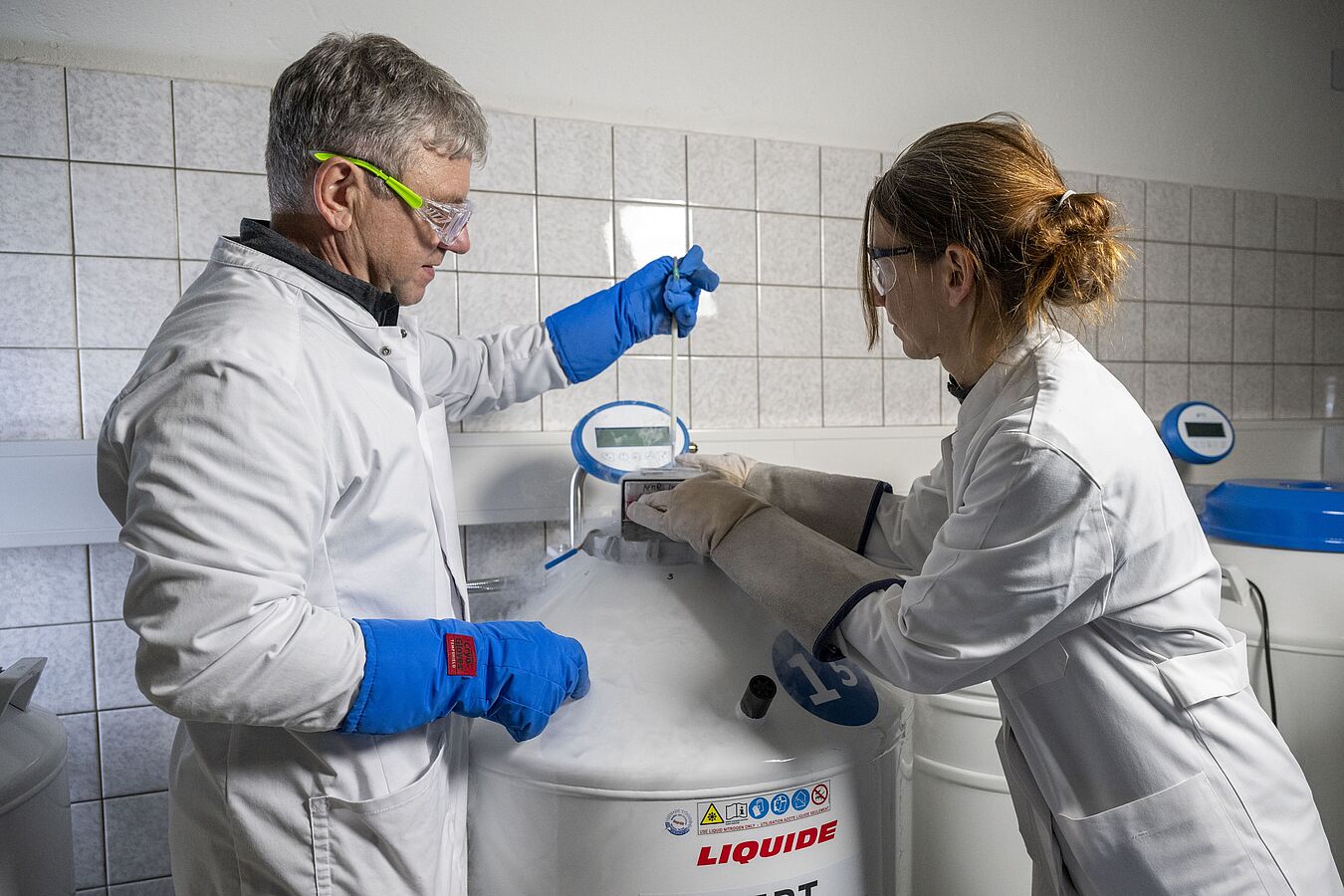In the face of the global biodiversity crisis, more and more biobanks are being set up to safeguard and potentially restore genetic diversity.

Cryostorage of biomaterial at the Leibniz-IZW | Photo: Jon A. Juarez
Preserved tissue or cells allow scientists and conservationists to overcome spatial and even temporal fragmentations of dwindling wildlife populations and employ assisted reproduction technologies - as long as biobanks can be used in a safe and ethically appropriate manner. In a new scientific paper in the journal "Cryobiology", the BioRescue team systematically evaluates these ethical considerations related to, among others, animal welfare, sample ownership and good scientific practice. The team also presents a modification of its "ETHAS" tool as a clear, easy-to-adopt and standardised technique for a structured and organised ethical assessment and decision making in the context of biobanking.
Together with recent advances in assisted reproduction technologies (ART), biobanks promise to be a technique of last resort for maintaining genetic diversity in dwindling wildlife populations and even for saving species from the brink of extinction. For example, the rescue mission for the northern white rhinoceros (the BioRescue project) relies both on new developments of techniques such as oocyte collection, in vitro fertilisation, embryo transfer and stem cell differentiation for rhinos, and on the possibility to safely store egg cell, semen or tissue samples in liquid nitrogen. Biobanking is a guarantee to have biomaterial at the team's disposal to develop these new techniques and employ them at suitable places and times. "We can bring together semen collected 20 years ago in North America with oocytes which were freshly collected in Kenya, create embryos in Italy and store them again in liquid nitrogen until we can transfer them into a surrogate mother", says BioRescue project head Prof Thomas Hildebrandt from the German Leibniz Institute for Zoo and Wildlife Research (Leibniz-IZW). "None of that would be possible without cryostorage, so we are in fact building and using an icy bridge across space and time and overcome the severe fragmentation of the species' genetic heritage for our mission."
However, these new technological possibilities raise new ethical questions, which the BioRescue team has addressed by adjusting and extending its Ethical Assessment tool for ART procedures "ETHAS" to biobanking. "If we establish new opportunities for conservation by the use of new technologies such as biobanking, we need to ensure that we make wise and transparent decisions for the environment and the ecosystem, for the welfare of the animals involved, for society and its institutions and regulations, as well as for good scientific practice", says Prof Barbara de Mori of Padua University, who heads the ethical research pillar in BioRescue. This includes issues such as
- how to select biomaterial that is stored in so-called genome research banks (GRBs) - to avoid a skewed representation of individuals and species for a broader conservation perspective;
- how to ensure the welfare of all animals involved - from the individuals from which samples are obtained to the individuals that will carry the preserved genetic information or act as surrogates in the context of ART;
- how to deal with ownership and benefit sharing when established storage and relatively easy transport opens doors to potentially exploitative parachute science - exporting biological and cultural heritage and generating profit at the expense of local communities with no benefits to these communities.
"Last but not least we need to make sure that we meet high scientific and material standards, prevent misuse, conduct our research and conservation activities with the required transparency and listen carefully to societal stakeholders in complex ethical questions of what should be done", sum up Hildebrandt and de Mori.
To help address these issues within scientific projects for conservation, BioRescue modified the established ethical assessment tool ETHAS so that it can be applied to biobanking of various types of biomaterial such as tissue, reproductive cells and embryos as well as cell cultures. "ETHAS is a checklist-based, systematic self-assessment tool that covers environmental ethics, animal welfare ethics, social ethics and research ethics of biobanking procedures", explains Dr Pierfrancesco Biasetti, scientist at the Leibniz-IZW. "ETHAS connects and integrates all ethical and regulatory considerations into a single framework and thereby provides a clear, relatively easy-to-adopt and standardised method for structuring and organising ethical analysis and ethical decision making." The goal is to ensure the highest ethical standards possible with a practical tool that can be incorporated in standard operating procedures.
The ethical evaluation of biobanking activities remains in its infancy, the BioRescue team sums up in the scientific paper; as does the integration of GRBs into the management of species of conservation concern. There is a pressing need not only to enhance ethical training for conservationists and biobanking practitioners but also to facilitate the establishment of GRBs as a pivotal strategy in supporting species conservation objectives. The collection and storage of samples and the development of living cell lines could then be seen as an integral part of routine conservation efforts rather than as exceptions - as should be its ethical evaluation.
Biasetti P, Mercugliano E, Schrade L, Spiriti MM, Göritz F, Holtze S, Seet S, Galli C, Stejskal J, Colleoni S, Čižmár D, Simone R, Hildebrandt TB, de Mori B (2024): Ethical assessment of genome resource banking (GRB) in wildlife conservation. Cryobiology 117, 104956.






